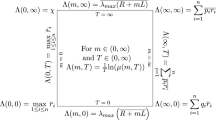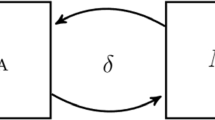Abstract
This paper studies influences of population dispersal on the dynamics of populations that live in patches and grow under Allee effect. Analytical conditions for the global stability of the model in the case of weak Allee effect are established by using the theory of monotonic dynamical systems. Numerical simulations are provided for the case of two patches and strong Allee effect, which reveal that a moderate migration to the better patch is beneficial to overall population, whereas a larger one is harmful.







Similar content being viewed by others
References
Amarasekare, P.: Interactions between local dynamics and dispersal: insights from single species models. Theor. Popul. Biol. 53, 44–59 (1998)
Arino, J., van den Driessche, P.: A multi-city epidemic model. Math. Popul. Stud. 10, 175–193 (2003)
Berman, A., Plemmon, R.J.: Nonnegative Matrices in the Mathematical Sciences, Classics in Applied Mathematics, vol. 9. Society for Industrial and Applied Mathematics (SIAM), Philadelphia (1994)
Berec, L.: Models of Allee effects and their implications for population and community dynamics. Biophys. Rev. Lett. 3, 157–181 (2008)
Boukal, D.S., Berec, L.: Single-species models of the Allee effect: extinction boundaries, sex ratios and mate encounters. J. Theor. Biol. 218, 375–394 (2002)
Courchamp, F., Berec, L., Gascoigne, J.: Allee Effects in Ecology and Conservation. Oxford University Press, Oxford (2008)
Cushing, J.M.: The evolutionary dynamics of a population model with a strong Allee effect. Math. Biosci. 12, 643–660 (2015)
Dennis, B.: Allee effects: population growth, critical density, and the chance of extinction. Nat. Resour. Model. 3, 481–538 (1989)
Dennis, B.: Allee effects in stochastic populations. Oikos 96, 389–401 (2002)
Du, Y., Shi, J.: Allee effect and bistability in a spatially heterogeneous predator–prey model. Trans. Am. Math. Soc. 359, 4557–4593 (2007)
Dhooge, A., Govaerts, W., Kuznetsov, Y.A.: MATCONT: A MATLAB package for numerical bifurcation analysis of ODEs. ACM Trans. Math. Softw. 29, 141–164 (2003)
Gao, D., Ruan, S.: A multipatch malaria model with logistic growth populations. SIAM J. Appl. Math. 72, 819–841 (2012)
Hirsch, M.W.: Stability and convergence in strongly monotone dynamical systems. J. Reine Angew. Math. 383, 1–53 (1988)
Kang, Y., Lanchier, N.: Expansion or extinction: deterministic and stochastic two-patch models with Allee effects. J. Math. Biol. 62, 925–973 (2011)
Keitt, T.H., Lewis, M.A., Holt, R.D.: Allee effects, invasion pinning, and species borders. Am. Nat. 157, 203–216 (2001)
Kramer, A.M., Dennis, B., Liebhold, A.M., Drake, J.M.: The evidence for Allee effects. Popul. Ecol. 51, 341–354 (2009)
Levin, S.A.: Dispersion and population interactions. Am. Nat. 108, 207–228 (1974)
McCarthy, M.A.: The Allee effect, finding mates and theoretical models. Ecol. Model. 103, 99–102 (1997)
Padrón, V., Trevisan, M.C.: Effect of aggregating behavior on population recovery on a set of habitat islands. Math. Biosci. 165, 63–78 (2000)
Smith, H.L.: Monotone Dynamical Systems. An Introduction to the Theory of Competitive and Cooperative Systems. Mathematical Surveys and Monographs, vol. 41. American Mathematical Society, Providence (1995)
Takeuchi, Y.: Diffusion-mediated persistence in two-species competition Lotka–Volterra model. Math. Biosci. 95, 65–83 (1989)
Takeuchi, Y., Lu, Z.: Permanence and global stability for competitive Lotka–Volterra diffusion systems. Nonlinear Anal. 24, 91–104 (1995)
Terry, A.J.: Predator–prey models with component Allee effect for predator reproduction. J. Math. Biol. 71, 1325–1352 (2015)
Wang, W., Fergola, P., Tenneriello, C.: Global attractivity of periodic solutions of population models. J. Math. Anal. Appl. 211, 498–511 (1997)
Wang, W., Fergola, P., Tenneriello, C.: Innovation diffusion model in patch environment. Appl. Math. Comput. 134, 51–67 (2003)
Wang, W., Zhao, X.: An epidemic model in a patchy environment. Math. Biosci. 190, 97–112 (2004)
Wang, W., Zhao, X.: An age-structured epidemic model in a patchy environment. SIAM J. Appl. Math. 65, 1597–1614 (2005)
Wang, W., Zhao, X.: An epidemic model with population dispersal and infection period. SIAM J. Appl. Math. 66, 1454–1472 (2006)
Wang, W., Ma, X.: Harmless delays for uniform persistence. J. Math. Anal. Appl. 158, 256–268 (1991)
Wang, W., Takeuchi, Y.: Adaptation of prey and predators between patches. J. Theor. Biol. 258, 603–613 (2009)
Xu, D., Feng, Z., Linda, J., S., Allen, Swihart, R.K.: A spatially structured metapopulation model with patch dynamics. J. Theor. Biol. 239, 469–481 (2006)
Zhang, X., Wang, W.: Influences of migrations from local competitive pressures on populations between patches. J. Appl. Math. Comput. 37, 313–330 (2001)
Zhao, X.Q.: Dynamical Systems in Population Biology. Springer, New York (2003)
Author information
Authors and Affiliations
Corresponding author
Additional information
This work was supported by the National Natural Science Found of China (11571284).
Rights and permissions
About this article
Cite this article
Wang, W. Population dispersal and Allee effect. Ricerche mat 65, 535–548 (2016). https://doi.org/10.1007/s11587-016-0273-0
Received:
Revised:
Published:
Issue Date:
DOI: https://doi.org/10.1007/s11587-016-0273-0




